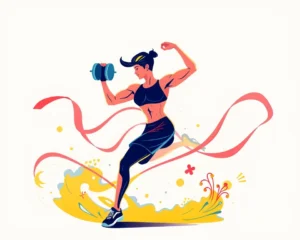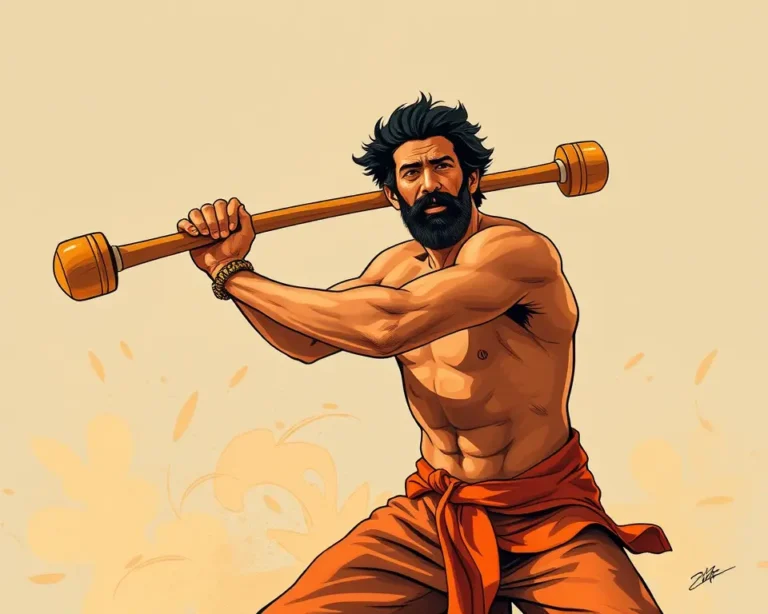Milind Soman, known for his dedication to fitness and unconventional workout routines, recently shared a video of himself wielding a gada, a traditional Indian mace, during his workout. The video, posted on his social media, quickly went viral, showcasing Soman’s commitment to incorporating ancient practices into his fitness regime. In his post, Soman humorously referred to channeling his inner Hanuman, the Hindu god known for his immense strength, while acknowledging the challenge the workout presented.
The Gada: A Symbol of Strength and Tradition
The gada is more than just a piece of exercise equipment; it is a symbol deeply rooted in Indian history and mythology.
- Historical Significance: The gada has been used for centuries in Indian martial arts and wrestling. It’s not just about brute strength; using it correctly requires technique, balance, and coordination.
- Mythological Context: As mentioned by Soman, the gada is strongly associated with Hanuman, who is often depicted carrying one. This association lends the gada a sense of reverence and tradition, connecting modern users to a rich cultural heritage.
- Construction: Traditionally, gadas are made of wood or metal and can vary significantly in weight. This allows for progressive overload, where users can gradually increase the weight as they get stronger.
Benefits of Gada Training
Gada training offers a range of physical benefits, making it a comprehensive workout tool.
- Full-Body Engagement: Swinging the gada engages multiple muscle groups simultaneously, including the shoulders, back, core, and legs.
- Grip Strength: The unique shape and weight distribution of the gada challenge grip strength, which is often overlooked in conventional workouts.
- Rotational Power: Gada exercises emphasize rotational movements, improving core stability and power, which can translate to better performance in other sports and activities.
- Shoulder Health: The swinging motions can improve shoulder mobility and stability, potentially reducing the risk of injuries.
- Balance and Coordination: Maintaining balance while swinging the gada requires focus and coordination, enhancing proprioception (awareness of your body in space).
Milind Soman’s Fitness Philosophy: A Blend of Tradition and Innovation
Milind Soman has consistently promoted a holistic approach to fitness that extends beyond conventional gym workouts.
- Embracing Indian Traditions: Soman frequently incorporates traditional Indian exercises and practices into his routines, such as running barefoot, yoga, and now, gada training. This reflects his belief in the wisdom of ancient methods.
- Focus on Functional Fitness: His workouts often emphasize functional movements that mimic real-life activities, improving overall strength, endurance, and mobility.
- Mental and Physical Well-being: Soman emphasizes the connection between physical and mental health, advocating for a balanced lifestyle that includes proper nutrition, adequate rest, and stress management.
- Inspiring Others: Through his social media presence and participation in fitness events, Soman inspires people of all ages to adopt a healthier lifestyle and challenge their limits.
Other Traditional Fitness Tools and Practices
The gada is just one example of the many traditional fitness tools and practices that are gaining renewed popularity.
- Mugdal: Another traditional Indian exercise tool, the mugdal is a club-like instrument swung in specific patterns to build strength and shoulder mobility.
- Vyayam: This refers to a range of traditional Indian bodyweight exercises, often performed in a rhythmic sequence, promoting strength, flexibility, and endurance.
- Yoga: An ancient Indian practice that combines physical postures, breathing techniques, and meditation to improve physical and mental well-being.
- Surya Namaskar: A sequence of yoga poses performed in a flowing manner, often practiced at sunrise to energize the body and mind.
How to Incorporate Gada Training Safely
If you’re interested in trying gada training, it’s essential to approach it safely and with proper guidance.
- Start with Proper Instruction: Seek guidance from a qualified instructor who can teach you the correct techniques and ensure you’re using the gada safely.
- Choose the Right Weight: Begin with a lighter gada to master the movements before gradually increasing the weight.
- Focus on Form: Proper form is crucial to prevent injuries. Focus on maintaining a stable core and controlled movements.
- Warm-up Properly: Prepare your body with dynamic stretches and light cardio before starting your gada workout.
- Listen to Your Body: Pay attention to any pain or discomfort and stop if you feel any sharp or unusual sensations.
- Progress Gradually: Don’t try to do too much too soon. Gradually increase the intensity and duration of your workouts as you get stronger.
Potential Risks and Precautions
While gada training offers many benefits, it’s important to be aware of potential risks and take precautions.
- Shoulder Injuries: Incorrect technique or excessive weight can lead to shoulder impingement, rotator cuff tears, or other shoulder injuries.
- Back Pain: Improper form or a weak core can strain the back muscles and lead to pain.
- Elbow and Wrist Pain: Repetitive movements or excessive force can cause elbow or wrist pain.
- Head Injuries: Accidental contact with the gada can result in head injuries. Always maintain a safe distance from others and be aware of your surroundings.
The Resurgence of Traditional Fitness Practices
The growing interest in gada training and other traditional fitness practices reflects a broader trend towards holistic wellness and a desire to connect with cultural roots.
- Dissatisfaction with Modern Fitness Trends: Some people are seeking alternatives to the often superficial and image-focused trends in modern fitness.
- Focus on Functional Movement: Traditional practices often emphasize functional movements that improve overall strength, mobility, and coordination, making them appealing to those seeking practical fitness solutions.
- Cultural Connection: Many people are drawn to traditional practices as a way to connect with their heritage and explore the wisdom of ancient cultures.
- Mind-Body Connection: Traditional practices often emphasize the connection between physical and mental well-being, promoting a holistic approach to health.
The Future of Fitness: A Blend of Old and New
The future of fitness is likely to involve a blend of traditional practices and modern techniques.
- Integration of Technology: Technology can be used to enhance traditional practices, such as using sensors to track movements and provide feedback on form.
- Personalized Training: Tailoring fitness programs to individual needs and preferences, incorporating both traditional and modern elements.
- Emphasis on Community: Creating supportive communities around fitness activities, fostering a sense of belonging and motivation.
- Holistic Approach: Promoting a holistic approach to health that encompasses physical, mental, and emotional well-being.
Milind Soman’s Enduring Influence
Milind Soman’s embrace of the gada and his commitment to promoting traditional fitness practices serve as an inspiration to many. His influence extends beyond physical fitness, encouraging people to explore their cultural roots and adopt a more holistic approach to health and well-being. By sharing his journey and experiences, Soman continues to inspire others to challenge their limits, embrace their heritage, and live healthier, more fulfilling lives.
- Advocating for Natural and Sustainable Practices: Soman consistently promotes natural and sustainable approaches to fitness and health, encouraging people to minimize their reliance on supplements and artificial products.
- Breaking Age Barriers: Soman’s own fitness achievements, including completing challenging endurance events at an older age, demonstrate that age is not a barrier to physical activity and well-being.
- Promoting Body Positivity: Soman encourages people to embrace their bodies and focus on health and well-being rather than striving for unrealistic beauty standards.
- Inspiring a Generation: Through his actions and words, Milind Soman has inspired a generation to prioritize their health, embrace their heritage, and live more fulfilling lives.







